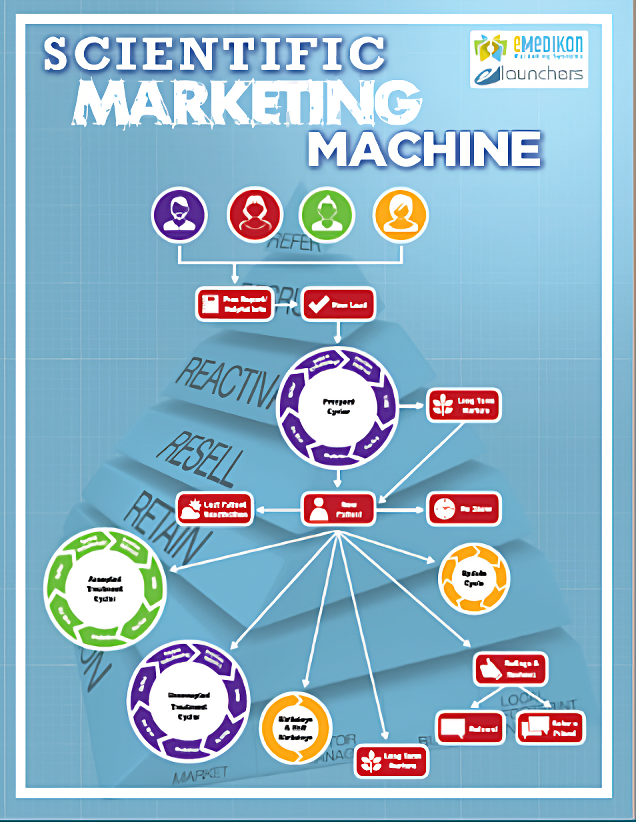The Ultimate Ophthalmic Marketing Guide
Chapter 11: Putting It All Together

Chapter 11: Putting It All Together
We hope by now you see the value of Scientific Marketing. Just as evidence-based medicine sometimes overturns prevailing thought when it comes to treating disease, evidence- based marketing can do the same. If you’re not measuring something, you don’t really know whether it’s working.
We’re not saying that there is no place for corporate identity marketing and brand awareness ads. Big companies do them all the time. But, for the most part, big companies can afford to spend (and waste) more money than you and I.
Medical practices have limited resources and should be justifying every dollar they spend, particularly in a day and age when increasing downward pressure on reimbursements affects our bottom line.
First, the 7 Rules of Dynamic Response Marketing (adapted from Dan Kennedy’s “No B.S. Rules of Direct Marketing” and Oliver Billson’s “Getting Explosive Results with Dynamic Response Marketing”):
Implementing The 7R Strategy
Now let’s turn our attention to the actual implementation of our 7R Strategy.
Set a marketing allocation budget instead of a marketing spending budget
What is the distinction here? Most practices, and most businesses, set up a marketing budget based on guidelines from their particular industry. Budgets are typi- cally based on a percentage of gross revenue – for example, 1–3% of gross revenue for a general ophthalmology practice and possibly higher for one specializing in refractive surgery. The job of the marketing director (if there is one) is to figure out ways to spend that money (because spend it they will). There is usually not a lot more corporate strategy with it than “We have $XXX thousand this year in our budget.” As you have hopefully learned by now, this is not the best way to de- termine how your money should be spent, let alone whether your marketing is effective.
With a marketing allocation budget, on the other hand, you begin with a strategy for how you will allocate funds for invest- ing in your marketing portfolio and then ramp up while you measure your results. If your practice is new to this, it might take half of its normal $100,000 annual marketing budget and allocate $50,000 to the 7R Scientific Marketing strategy and
$50,000 to typical brand marketing.
As your funnels are tested and campaigns begin to show re- turns (because now you are tracking everything, right?), you and your partners can agree that a certain percentage of that ROI (perhaps one-third) should be invested back into more marketing. Eventually, you will be investing more and more because you are recognizing more revenue. So, in Year 2, you might be allocating $90,000 Scientific Marketing while still spending the original $50,000 on traditional brand aware- ness. But that $40,000 you added came from profit generated from returns that would not have been realized without mar- keting scientifically.
Adopt an 18-month rolling marketing budget
You review, reallocate, divest, or invest during quarterly budget reviews in- stead of deciding in November what your next year’s annual spend will be and never giving it another thought until next November!
Make an inventory...
...of every marketing project, program, or process that you spend money on now and that you intend to spend money on for the next 12 months. Tag each of these items with one or more of the R’s so that it maps investment to strategy.

Fig 20. Examples of how marketing investments map to the 7R Strategies
Set goals for each premium service
If you want premium cataract surgery revenue to increase by 100%, then you will need to invest accordingly. How much, exactly? Well, that will depend on where you are starting from. How do you compare with the competition? What is your market share? What is your poten- tial wallet share? How much unused capacity does your practice have? Your ASC/your surgeons?
Set up a performance dashboard...
...with metrics that matter, not just metrics that can be captured. Most practices set only revenue (sales) goals and don’t manage marketing with rele- vant marketing metrics. In each step of your marketing fun- nel, what are your conversion goals? What is the comparison between planned and actual? The metrics you put in place should be carefully selected as leading indicators and lag- ging indicators. These are known as KPIs (key performance indicators).
Leading indicators are activities and behaviors that reveal potential results (number of LASIK inquires is a leading indicator of LASIK sales). They can mark milestones in the buying journey – things such as funnel page bounce rate, domain where visitors came from, email opt-ins, or click-to-call actions from a web page.
After opt-ins you could then track email opens on a welcome email that goes out automatically, an email that also includes a link that tracks clicks. The link could take people to a video that tracks whether they watch it all the way through, and the video has a call to action that also tracks whether they did what you asked them to do (call, visit another link, download a report, visit your online store, etc.).
Lagging indicators are things such as revenue and profit. Think of it like the balance in your bank account. You can’t add to your bank account by tracking and measuring your balance.
You use metrics to answer the following questions:
Employ marketing technology...
....to manage, track, and measure your campaigns. Using the appropriate enabling technology is central to doing Dynamic Response Scientific Marketing. Yes, Outlook and Excel are cheap and easy. But they are woefully inadequate to handle email lists, manage and measure email drip campaigns, capture, document, and optimize market- ing processes or do process mapping, manage and track sales pipelines, manage a portfolio of multiple campaign projects, and facilitate customer relationship management, to name just some of the various aspects of your scientific marketing program technology.

Figure 21. Example process flow for a practice- wide scientific marketing machine
Allocate time to master the marketing technology...
...if you are not going to hire consultants to run your marketing software for you. Every application needs a designated super-user, just like you did with your EMR (hopefully). This is both your highest opportunity cost and your highest productivity cost. Don’t trivialize the learning curve required by some marketing platforms. In most cases it is cheaper in the long run to hire arms and legs competent in running the tools than it is to groom talent from within.
Set up a marketing project center to manage your marketing portfolio
This should be an online tool (easier for all interested parties and partners) where you can see each active project, marketing pro- gram, and management process in one place (see the Resources section at the end of this book). Alongside the project name, you will need to be able to see the health of the project (on time, on budget, within scope), the responsible parties (both your practice and key vendor personnel), milestone dates, and some comments about dependencies, issues, opportunities, and bottlenecks/barri- ers that keep the project or process from running smoothly.
Feed the winners. Kill the losers.
This is the only place where the analogy of an investment portfolio does not apply to your marketing. In financial investing, dollar-cost averaging is used to buy stocks when they are low and sell them when they are high. In marketing investing, you reinvest in marketing campaigns that are winners and if, after A/B split-testing (keep reading …), conversion rates cannot be improved, you stop investing in the losers. It is important to note, however, that a losing campaign should first be evaluated for why it is losing and then tested to confirm your hypothesis. Sometimes a slight tweak of the messaging or another variable can turn it into a winner. This is called A/B split-testing against the original campaign (A, the control) to see which one is better; if B is the winner, it becomes the new control and is then split-tested against another tweaked version, and the winner of those two moves on (and so on).
Sophisticated eCommerce companies will split-test the font color of their headline or the size of the font; in these large companies, an increase in conversion of even 1% can equal millions of dollars. This improvement would never be realized unless they were continually split-testing variables.
Here’s An Idea: A Marketing “Wheel Of Fortune”

Figure 22. Hub-and-spoke model showing optical services as the revenue engine (hub) and general ophthalmology and premium services as the spokes extending out from it. The outer wheel is the continuity/ annuity program of annual eye exams that keeps things going
Implementation Checklist
Key Takeaways
Share this guide on your social media account with the buttons below
Activate Your First Scientific Marketing Funnel Today!
Time to Act ... Now ... Today!
We have a LASIK Lead Capture Funnel for you to try! Email [email protected] and put “LASIK F.U.E.L. Offer” in the subject line. Make sure the appropriate person’s contact info is in the email. Your funnel activation starts with a 15-minute setup call. (F.U.E.L. stands for Follow Up Every Lead.)
